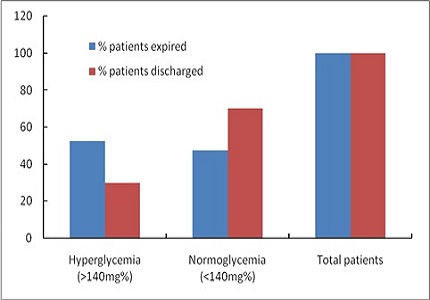Title: Hyperglycemia in critically ill patients and its association with increased mortality. A hospital based observational study
Abstract
Objective: Hyperglycemia is an independent risk factor in critically ill patients, contributing to increased mortality and morbidity. This study was conducted to see the adverse effects of hyperglycemia in the form of increased mortality in medical ICU patients. This Stress induced hyperglycemia is a well known entity and has been found to be associated with adverse outcome in various studies conducted worldwide but the data in India especially in the remote north eastern part is lacking. This will help to predict the prognosis and timely intervention.
Methods: This descriptive observational study was carried out amongst patients admitted in medical intensive care unit in a tertiary care hospital in Sikkim. Medical records of the patients between July 2015 to December 2015 were reviewed. Patients with admission hyperglycemia (>140 mg %) were chosen for the study irrespective of previous history of diabetes mellitus. Outcome in the form of discharge or death was noted. After fulfilling the inclusion criteria, 160 patients were selected. Chi square test was used to analyze the quantitative data at p<0.05 and CI-95%. Results are presented using percentage.
Results: Patients with admission hyperglycemia (>140 mg %) had significantly higher mortality as compared to patients with normal blood glucose level (p-0.0063, CI-1.347 - 4.936, OR-2.5) This relationship existed both in diabetics as well as new onset hyperglycemics.
Conclusion: In hospital, hyperglycemia is an independent predictor of mortality in critically ill patients.
Downloads
References
2. Siegelar S, Holleman F, Hoekstra JB, Devries JH. Glucose variability; Does it matter? Endocrine Rev. 2010; 31: 171–182. [PubMed]
3. Monnier L, Colette C, Owens DR. Integrating glycaemic variability in the glycaemic disorders of type 2 diabetes: a move towards a unified glucose tetrad concept. Diabetes Metab Res Rev. 2009;25(5):393-402. doi: 10.1002/dmrr.962.
4. Inzucchi S.E. Management of Hyperglycemia in the Hospital Setting. N Engl J Med. 2006; 355:1903-1911.
5. Umpierrez GE, Isaacs SD, Bazargan N, You X, Thaler LM, Kitabchi AE. Hyperglycemia: an independent marker of in-hospital mortality in patients with undiagnosed diabetes. J Clin Endocrinol Metab. 2002;87(3):978-82. [PubMed]
6. Cook CB, Kongable GL, Potter DJ, Abad VJ, Leija DE, Anderson M. Inpatient glucose control: a glycemic survey of 126 U.S. hospitals. J Hosp Med. 2009;4(9):E7-E14. doi: 10.1002/jhm.533. [PubMed]
7. Schmeltz LR, DeSantis AJ, Thiyagarajan V, Schmidt K, O'Shea-Mahler E, Johnson D, Henske J, McCarthy PM, Gleason TG, McGee EC, Molitch ME. Reduction of surgical mortality and morbidity in diabetic patients undergoing cardiac surgery with a combined intravenous and subcutaneous insulin glucose management strategy. Diabetes Care. 2007;30(4):823-8.
8. Van den Berghe G, Wouters P, Weekers F, Verwaest C, Bruyninckx F, Schetz M, Vlasselaers D, Ferdinande P, Lauwers P, Bouillon R. Intensive insulin therapy in critically ill patients. N Engl J Med. 2001;345(19):1359-67.
9. Mikhail Kosiborod. Blood glucose and its prognostic implications in patients hospitalised with acute myocardial infarction. Diabetes & Vascular Disease Research . 2008; 5(4):269-75. doi: 10.3132/dvdr.2008.039.
10. Sung J, Bochicchio GM, Joshi M, et al. Admission hyperglycemia predictive of outcome in critically ill trauma patients. J Trauma.2005;59(1):80-83. [PubMed]
11. Greci LS, Kailasam M, Malkani S, Katz DL, Hulinsky I, Ahmadi R, Nawaz H Utility of HbA(1c) levels for diabetes case finding in hospitalized patients with hyperglycemia. Diabetes Care. 2003;26(4):1064-8. [PubMed]
12. Furnary, AP, Gao, G, Grunkemeier, GL, Wu, Y, Zerr, KJ, Bookin, SO et al, Continuous insulin infusion reduces mortality in patients with diabetes undergoing coronary artery bypass grafting. J Thorac Cardiovasc Surg. 2003;125:1007–1021. [PubMed ]
13. Jiang HJ, Stryer D, Friedman B, Andrews R Multiple hospitalizations for patients with diabetes. Diabetes Care. 2003;26(5):1421-6. [PubMed]
14. Malmberg K, Ryden L, Efendic S, et al. Randomized trial of insulin-glucose infusion followed by subcutaneous insulin treatment in diabetic patients with acute myocardial infarction (DIGAMI study): effects on mortality at 1 year. J. Am.Coll. Cardiol. 1995;26:57–65. Doi:10.1016/0735-1097(95)00126-K.
15. Van den Berghe G, Wilmer A, Hermans G, Meersseman W, Wouters PJ, Milants I, Van Wijngaerden E, Bobbaers H, Bouillon R Intensive insulin therapy in the medical ICU. N Engl J Med. 2006 ;354(5):449-61. [PubMed]
16. Pomposelli JJ, Baxter JK, III, Babineau TJ, et al. Early postoperative glucose control predicts nosocomial infection rate in diabetic patients. JPEN J. Parenter. Enteral. Nutr. 1998;22:77–81.
17. Clement S, Braithwaite SS, Magee MF, Ahmann A, Smith EP, Schafer RG, Hirsch IB. American Diabetes Association Diabetes in Hospitals Writing Committee. Management of diabetes and hyperglycemia in hospitals. Diabetes Care. 2004;27(2):553-91.
18. Furnary AP, Zerr KJ, Grunkemeier GL, Starr A. Continuous intravenous insulin infusion reduces the incidence of deep sternal wound infection in diabetic patients after cardiac surgical procedures. Ann Thorac Surg. 1999;67(2):352-60.
19. Falciglia M, Freyberg RW, Almenoff PL, D'Alessio DA, Render ML Hyperglycemia-related mortality in critically ill patients varies with admission diagnosis. Crit Care Med. 2009;37(12):3001-9. doi: 10.1097/CCM.0b013e3181b083f7. [PubMed]
20. Brunkhorst F.M, Engel C, Bloos F, et al. Intensive Insulin Therapy and Pentastarch Resuscitation in Severe Sepsis. N Engl J Med. 2008; 358:125-139. [PubMed]
21. De La Rosa GC, Donado JH, Restrepo AH, et al. Strict glycaemic control in patients hospitalised in a mixed medical and surgical intensive care unit: a randomised clinical trial. Crit. Care. 2008;12(120):1–9.
22. Donald E.G. Griesdale, Russell J. de SouzaRob M. van Dam, Daren K. Heyland, Deborah J. Cook, Atul Malhotra, Rupinder Dhaliwal, William R. Henderson, Dean R. Chittock,Simon Finfer, Daniel Talmor, Intensive insulin therapy and mortality among critically ill patients: a meta-analysis including NICE-SUGAR study data. CMAJ.2009; 180 (8) doi:10.1503/cmaj.090206 [PubMed]
23. Preiser JC, Brunkhorst F. Tight glucose control and hypoglycemia. Crit.Care.Med. 2008;36:1391–1392.



 OAI - Open Archives Initiative
OAI - Open Archives Initiative


